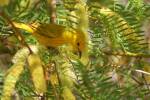OUTDOOR BRIEF
WAITING FOR ANALYSIS
Raptor surveys show population trends
The official start of summer signals that winter raptor surveys and spring breeding raptor surveys are now complete and Nevada Department of Wildlife biologists soon will be analyzing the data.
What does the data from the two surveys show? Although it takes some time to completely analyze all the numbers, certain trends in populations can be determined. Some species are increasing in numbers in their winter territory, while others are not faring as well. This can signal which species may need more attention. Breeding survey information also is one of the tools used to determine quotas for the sport of falconry.
According to NDOW wildlife diversity biologist Teri Slatauski, "The 2009 northern goshawk surveys appear to be trending toward a decline in occupancy. This signals a need for follow-up surveys before recommendations can be made to the wildlife commission regarding falconry regulations and quotas for the bird."
Conversely, there is good news for two other species. Both the peregrine falcon and the bald eagle are Endangered Species Act success stories, having recovered from drastic population declines in years past because of eggshell thinning as a result of the use of pesticides such as DDT. Peregrines were removed from the federal endangered species list in 1999.
"2010 was a record year for bald eagles at Lakes Mead and Mojave, with the highest count recorded in recent years," said Christy Klinger, NDOW wildlife diversity biologist.
The increase in peregrines in Southern Nevada is due to improved recruitment (more young) and possible movement of birds northward out of the canyon lands of Arizona, though some of the increase in survey numbers may be the result of increased survey efforts. "We have definitely seen an expansion of peregrine falcons, at least in southern Nevada, in the past two decades," Tomlinson added.
It is important to monitor the movement and nesting success of these birds as it relates the health of ecosystems. Many of these birds migrate in the winter to Southern Nevada from other areas. They spend the winter resting and foraging in a warmer climate where more food is available before they return to more northern climes. Others that reside here are year-round residents that nest, breed, and fledge their young in the spring.
Through their breeding raptor surveys, NDOW biologists determine territory occupancy and breeding status in the spring. The winter surveys, on the other hand, determine general trends of wintering raptors in the late winter and early spring. Some of the species that are monitored in these two surveys include bald and golden eagles, peregrine and prairie falcons, northern goshawks, Cooper's hawks, red-tailed hawks, ferruginous hawks and great horned owls.
"These species are protected by the Migratory Bird Treaty Act, as well as being state-protected, and are important in the ecosystem as they are at the top of the food chain," said Cris Tomlinson, NDOW supervising wildlife diversity biologist.
Winter raptor surveys usually occur between December and February, and breeding season raptor surveys usually occur from March through July. The latter is done by observing an adult bird on repeated occasions, a pair in a known nesting territory or suitable habitat, an adult on a nest or either eggs or offspring. Biologists in NDOW's diversity division conduct the surveys, often in collaboration with other agencies and groups such as the U.S. Fish and Wildlife Service, Bureau of Land Management and National Park Service and the Great Basin Bird Observatory. Many of the winter raptor surveys can be done by vehicle, while breeding surveys are generally done from the ground with the aid of spotting scopes and binoculars. However, some breeding raptors are surveyed from a helicopter so biologists can cover more ground in less time. Species surveyed from helicopters include the peregrine falcon, northern goshawk and ferruginous hawks. These survey flights are often followed up by on-the-ground efforts to verify the birds' nesting stage and status.
Northern goshawks occupy aspen habitats in riparian drainages. They can sometimes be located using acoustic surveys, where the biologist listens for a response call after playing a recorded alarm call.
Peregrine falcons are surveyed according to a stringent protocol established by the U.S. Fish and Wildlife Service in its delisting monitoring plan. NDOW and other participating organizations are field testing a "call-broadcast" survey method for peregrines, which appears to be an effective method for determining the bird's presence during certain times in the spring.























